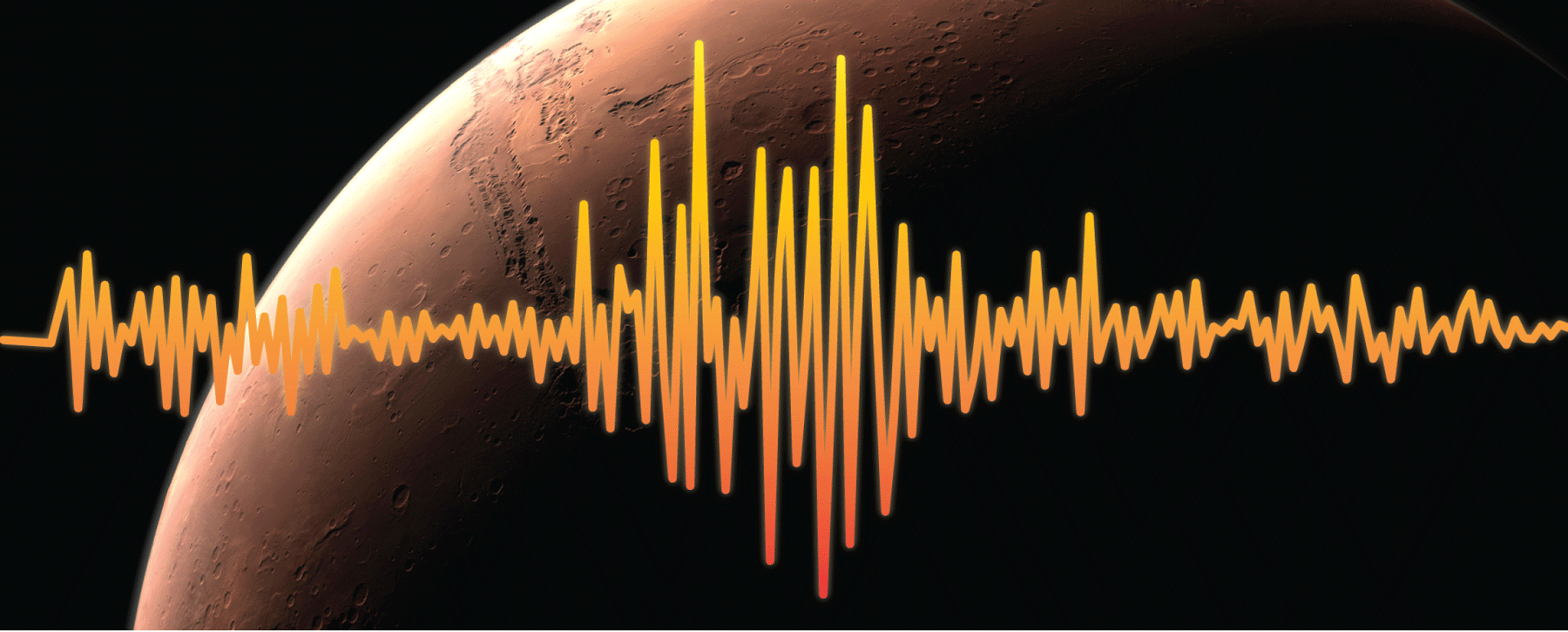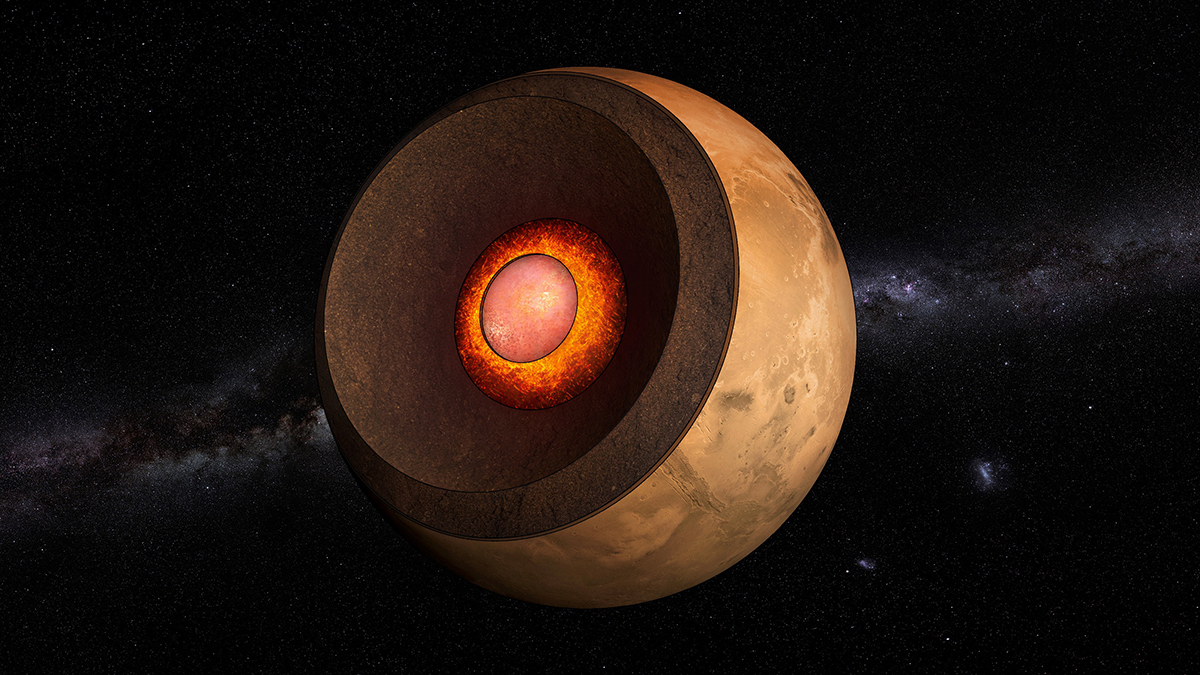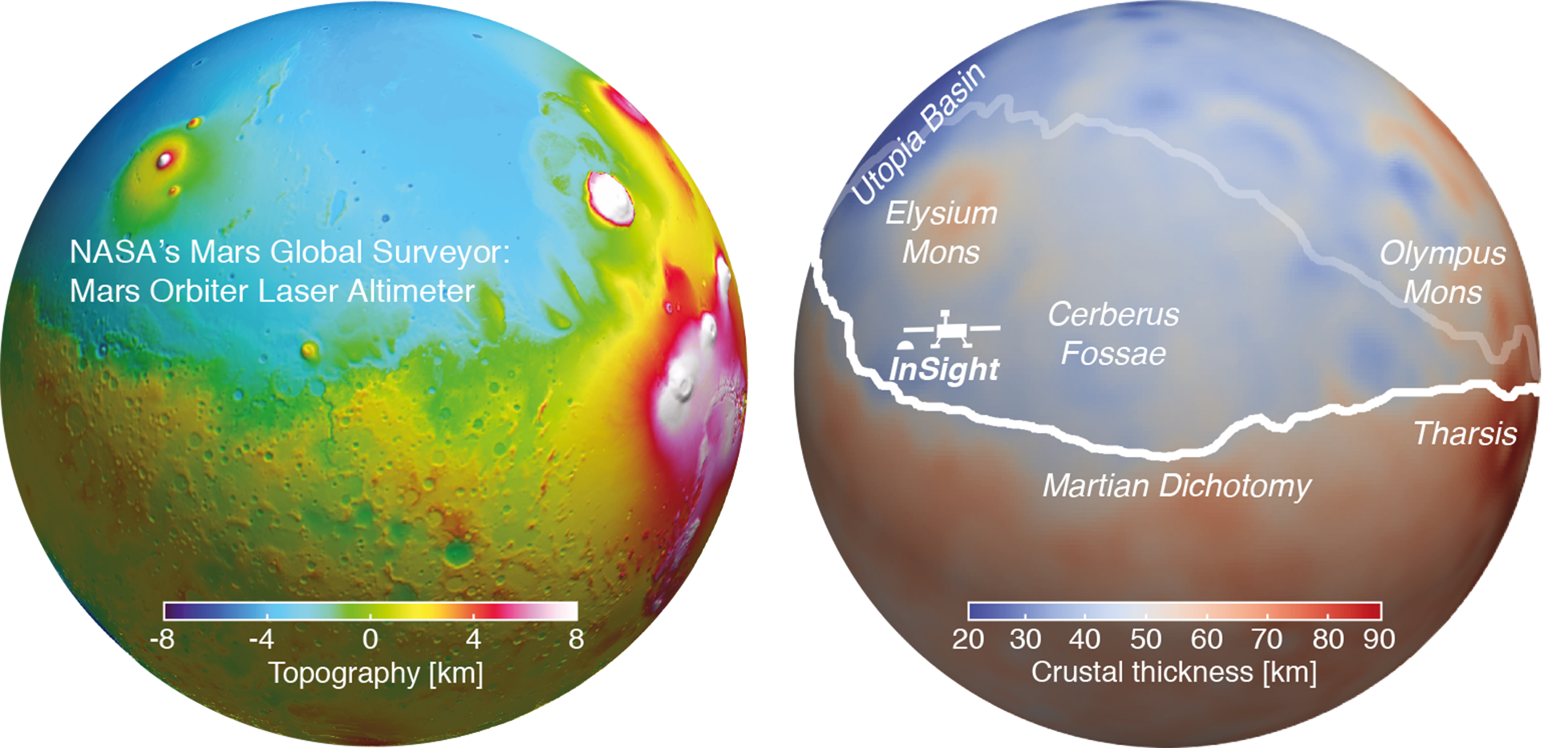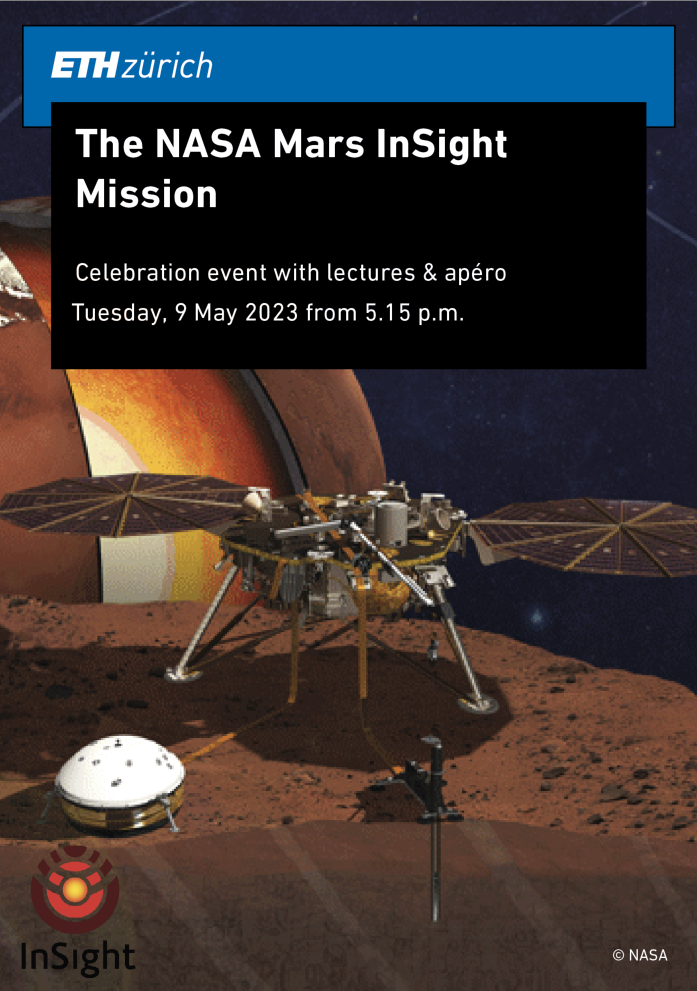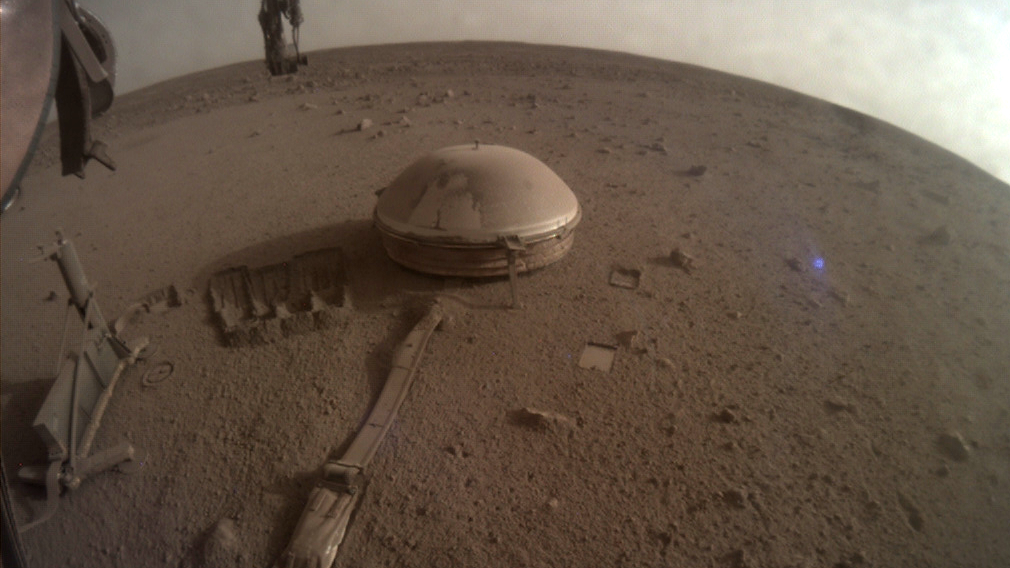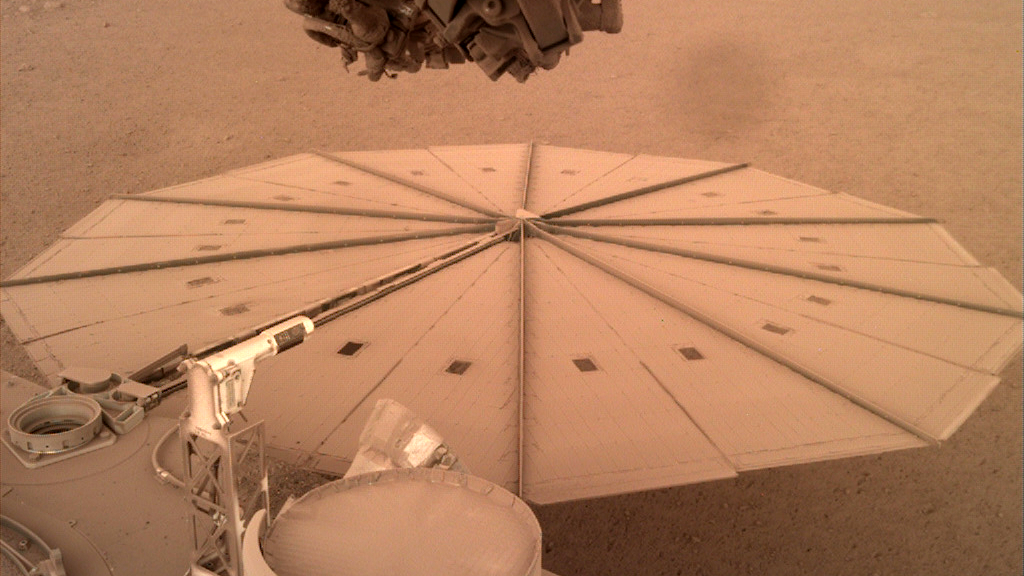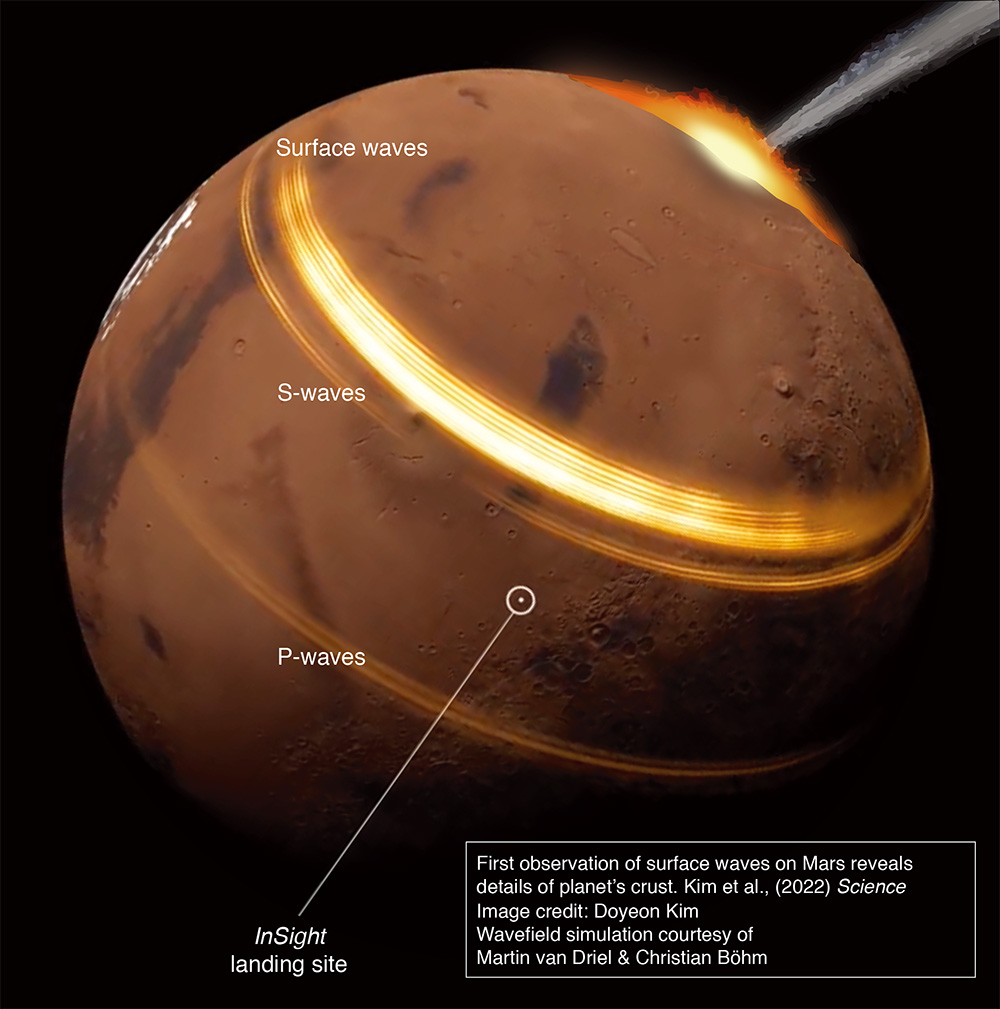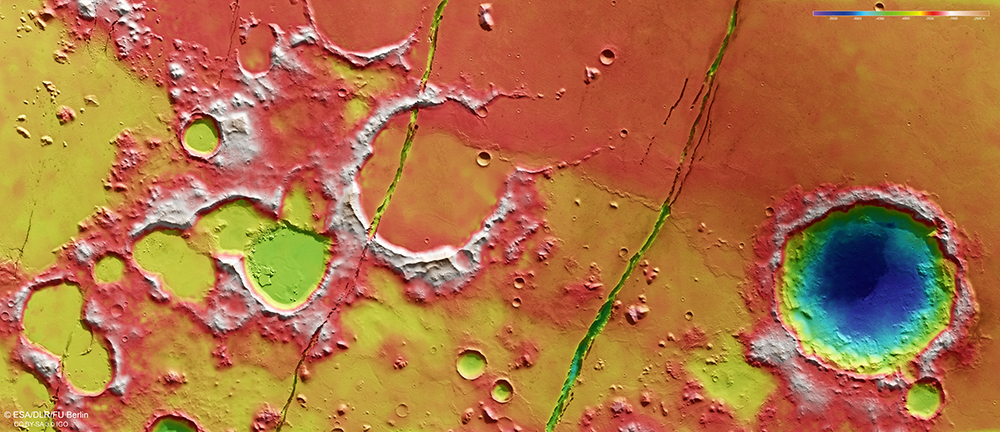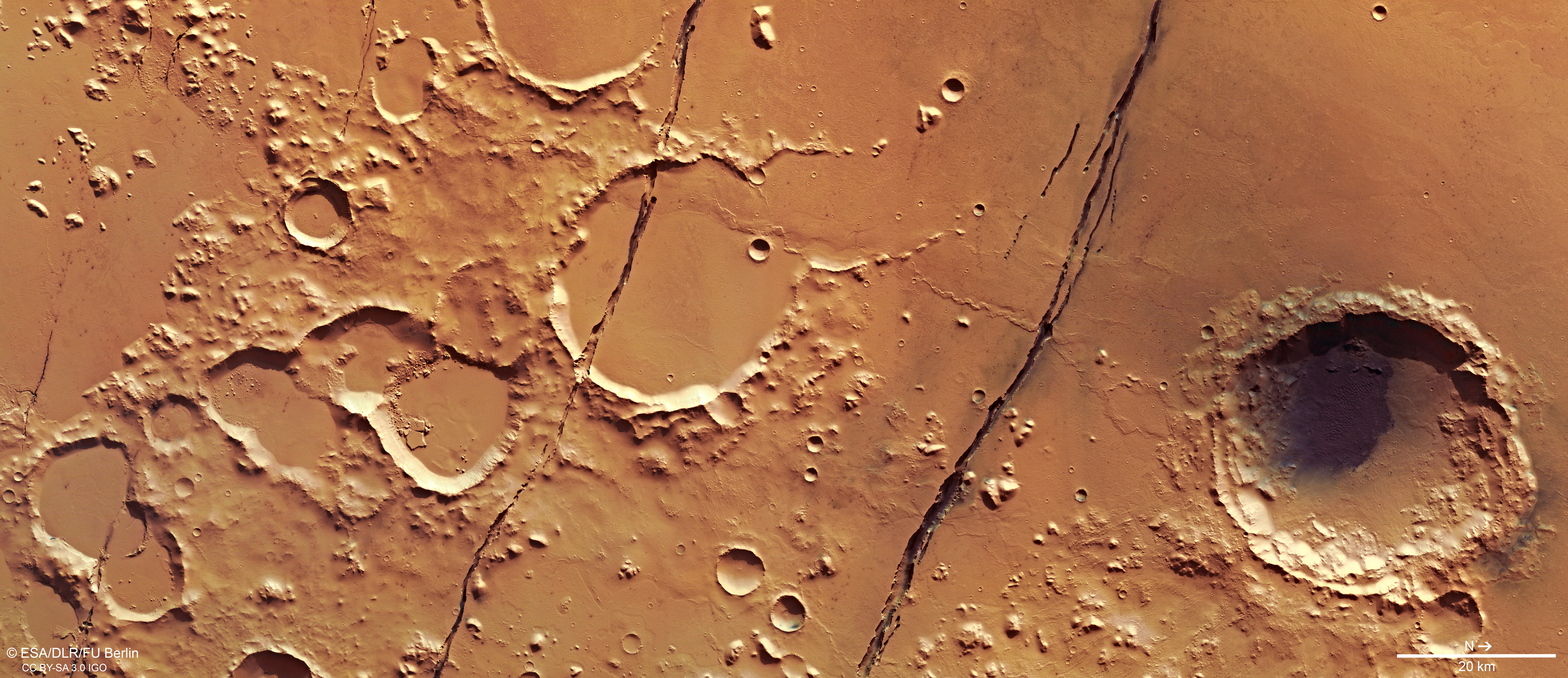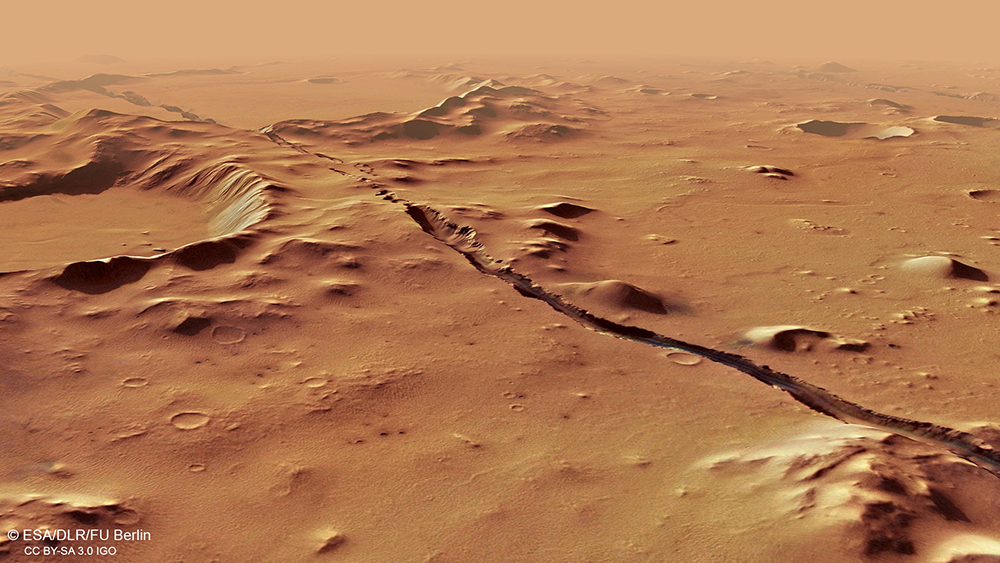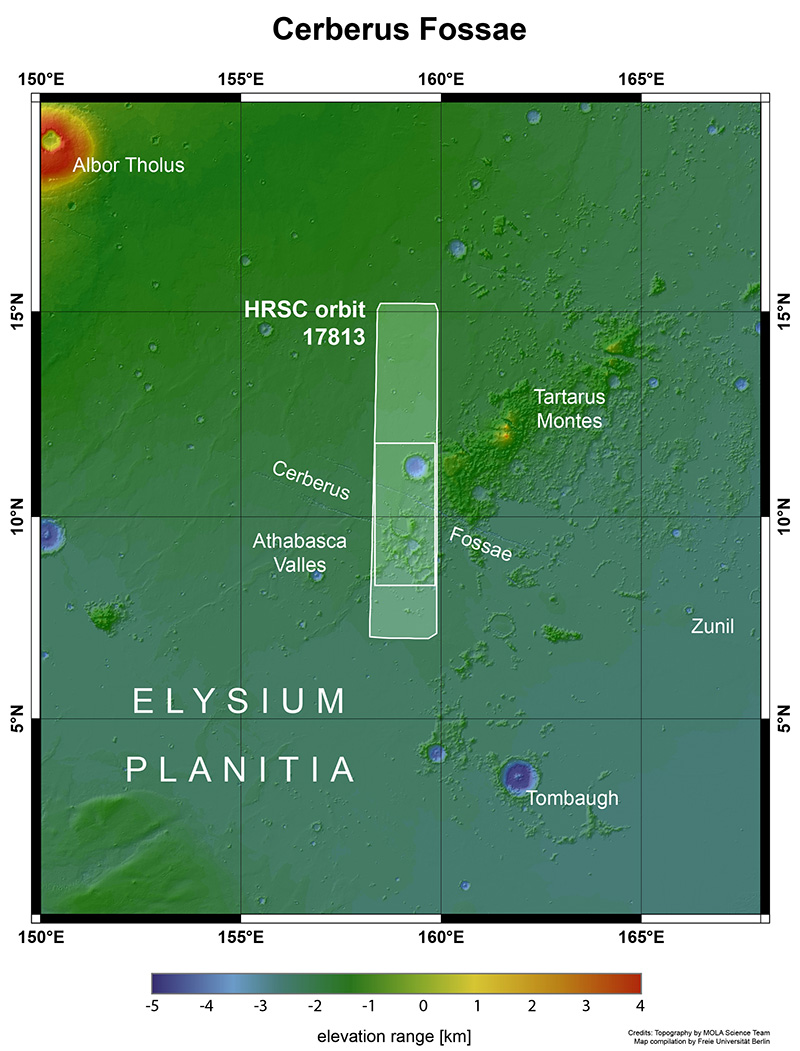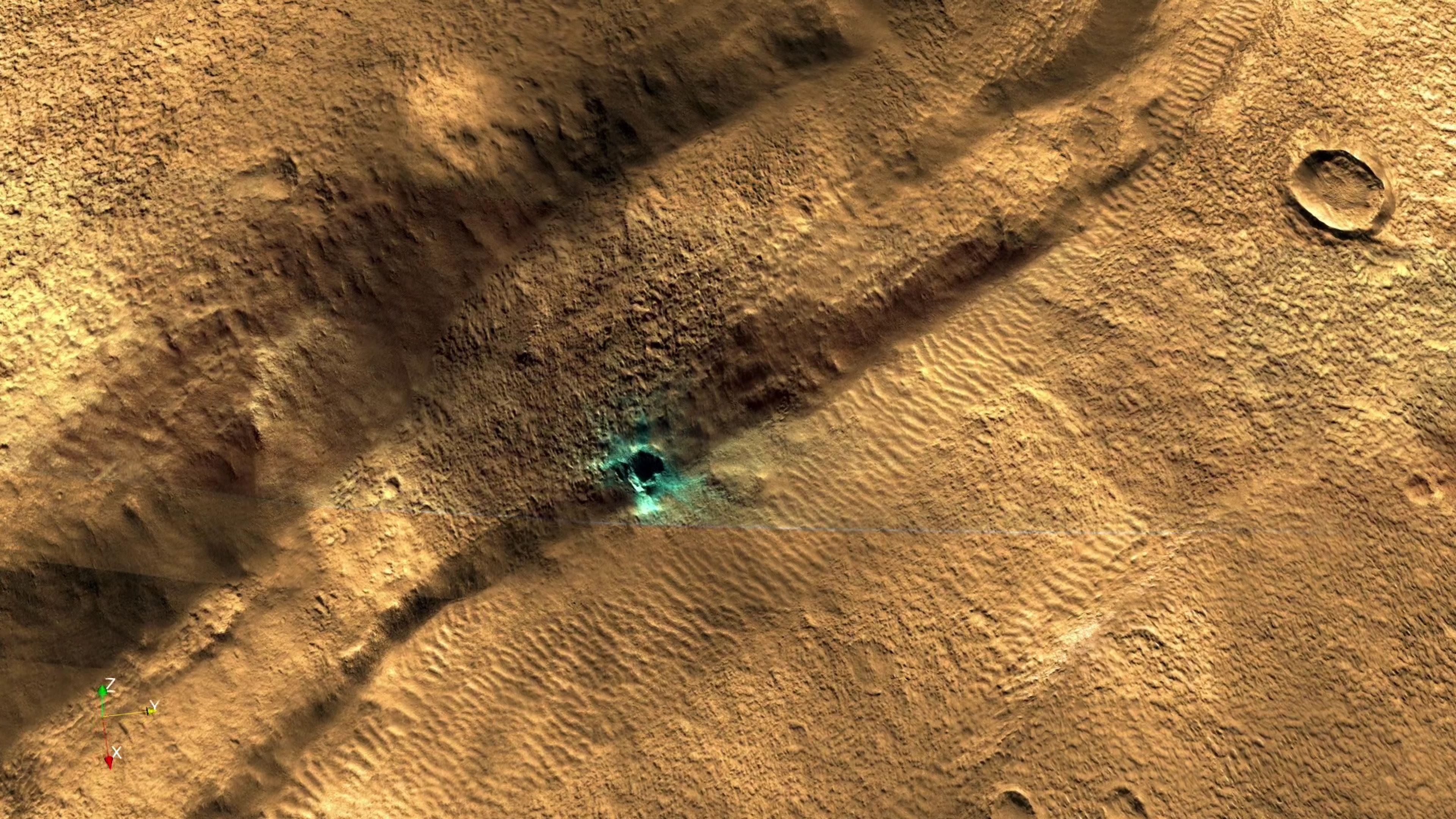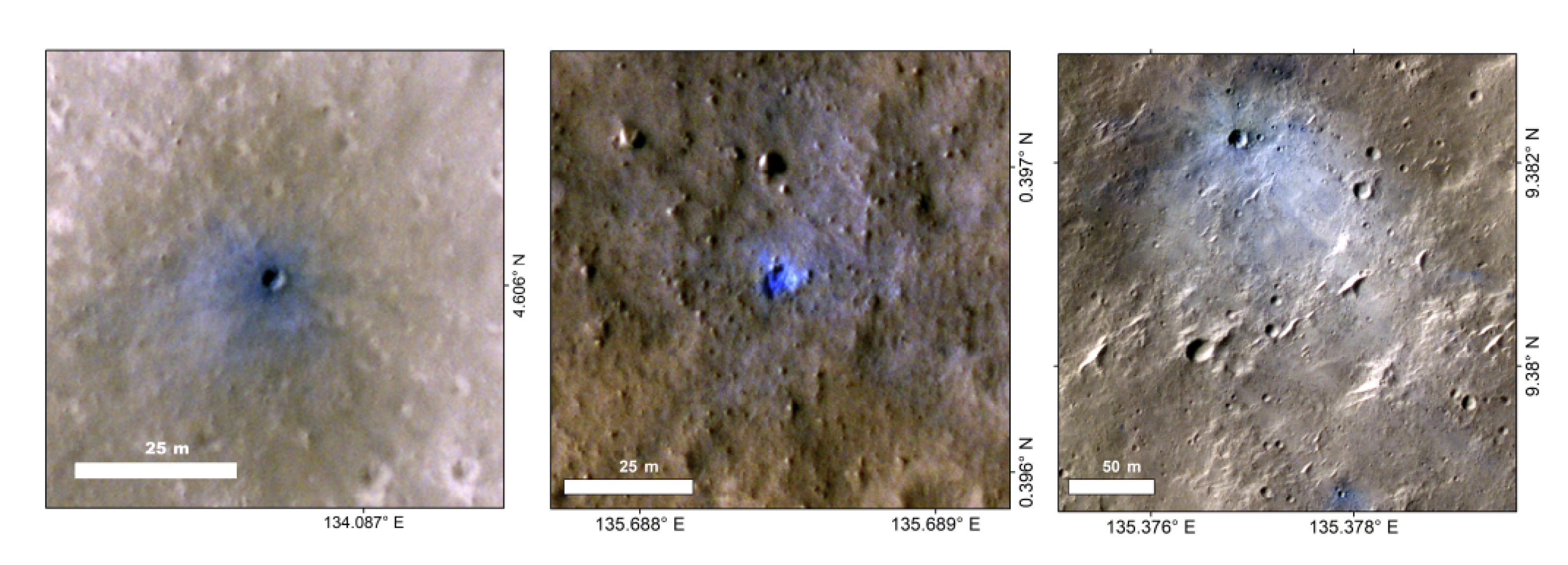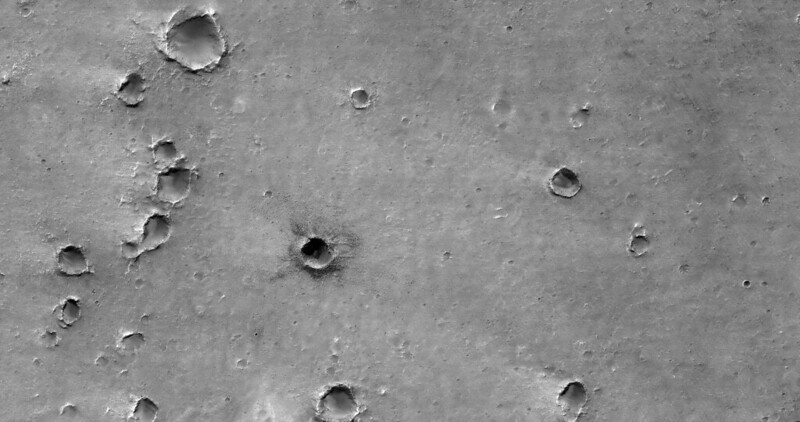2023-10-25
Mystery of the Martian core resolved
Mars’s liquid iron core is smaller and denser than previously thought. Not only is it smaller, but it is also surrounded by a layer of molten rock. This is what ETH Zurich researchers conclude on the basis of seismic data from the InSight lander.
For four years, Nasa’s InSight lander recorded tremors on Mars with its seismometer. Researchers at ETH Zurich collected and analysed the data transmitted to Earth to determine the planet’s internal structure. “Although the mission had already ended in December 2022, we’ve now discovered something very interesting,” says Amir Khan, a senior scientist in the Department of Earth Sciences at ETH Zurich.
An analysis of recorded marsquakes, combined with computer simulations, paint a new picture of the planet’s interior. Sandwiched between Mars’s liquid iron alloy core and its solid silicate mantle lies a layer of liquid silicate (magma) about 150 kilometres thick. “Earth doesn’t have a completely molten silicate layer like that,” Khan says.
This finding, now published in the scientific journal Nature alongside a study led by Henri Samuel of the Institut de Physique de Globe de Paris that reaches similar conclusions using complimentary methods, also provides new information on the size and composition of Mars’s core, resolving a mystery that researchers have hitherto been unable to explain.
An analysis of the initially observed marsquakes had shown that the average density of the Martian core had to be significantly lower than that of pure liquid iron. The Earth’s core, for example, consists of about 90 percent iron by weight. Light elements such as sulphur, carbon, oxygen and hydrogen make up a combined total of around 10 percent by weight. Initial estimates of the density of the Martian core showed that it comprised a much larger share of light elements – around 20 percent by weight. “This represents a very large complement of light elements, bordering on the impossible. We have been wondering about this result ever since,” says Dongyang Huang, a postdoctoral researcher in the Department of Earth Sciences at ETH Zurich.
Fewer light elements
The new observations show that the radius of the Martian core has decreased from the initially determined range of 1,800–1,850 kilometres to somewhere in the range of 1,650– 1,700 kilometres, which is about 50 percent of the radius of Mars. If the Martian core is smaller than previously thought but has the same mass, it follows that its density is greater and that it therefore contains fewer light elements. According to the new calculations, the proportion of light elements drops to between 9 and 14 percent by weight. “This means that the average density of the Martian core is still somewhat low, but no longer inexplicable in the context of typical planet formation scenarios,” says Paolo Sossi, Assistant Professor in the Department of Earth Sciences at ETH Zurich and member of the NCCR PlanetS. That the Martian core contains a significant amount of light elements indicates that it must have formed very early, possibly when the Sun was still surrounded by the nebula gas from which light elements could have accumulated in the Martian core.
The initial calculations were based on tremors that had occurred in close proximity to the InSight lander. However, in August and September 2021, the seismometer registered two quakes on the opposite side of Mars. One of them was caused by a meteorite impact. “These quakes produced seismic waves that traversed the core,” explains Cecilia Duran, a doctoral student in the Department of Earth Sciences at ETH Zurich. “This allowed us to illuminate the core.” In the case of the earlier marsquakes, by contrast, the waves were reflected at the core-mantle boundary, providing no information about the deepest interior of the Red Planet. As a result of these new observations, the researchers have now been able to determine the density and seismic wave speed of the fluid core up to a depth of about 1,000 kilometres.
Supercomputer simulations
To infer the composition of the material from such profiles, researchers usually compare the data with that of synthetic iron alloys containing different proportions of light elements (S, C, O, and H). In the lab, these alloys are exposed to high temperatures and pressures equivalent to those found in Mars’s interior, allowing researchers to measure density and seismic wave speed directly. At the moment, however, most experiments are conducted at conditions prevailing in the Earth’s interior and are therefore not immediately applicable to Mars. Consequently, the ETH researchers resorted to a different method. They computed the properties of a wide variety of alloys using quantum-mechanical calculations, which they carried out at the Swiss National Supercomputing Centre (CSCS) in Lugano.
When the researchers compared the calculated profiles with their measurements based on the InSight seismic data, they encountered a problem, however: it turned out that no iron-light element alloys simultaneously matched the data at both the top and centre of the Martian core. At the core-mantle boundary, for example, the iron alloy would have had to contain much more carbon than in the core’s interior. “It took us a while to realise that the region we had previously considered to be the outer liquid iron core wasn’t the core after all, but the deepest part of the mantle,” explains Huang. In support of this, the researchers also found that the density and seismic wave speed measured and computed in the outermost 150 kilometres of the core were coincident with those of liquid silicates – the same material, in solid form, of which the Martian mantle is composed.
Further analysis of earlier marsquakes and additional computer simulations confirmed this result. It is only regrettable that dusty solar panels and the resulting lack of power made it impossible for the InSight lander to provide additional data that could have shed more light on the composition and structure of Mars’s interior. “Yet InSight was a very successful mission that provided us with a lot of new data and insights that will be analysed for years to come,” Khan says.
References
Khan A, Huang D, Duran C, Sossi PA, Giardini D, Murakami M: Evidence for a liquid silicate layer atop the Martian core. Nature, 26 Oct 2023, doi: 10.1038/s41586-023-06586-4
Samuel H, Drilleau M, Rivoldini A, et al. Geophysical evidence for an enriched molten silicate layer above Mars' core, Nature, 26 Oct 2023, doi: 10.1038/s41586-023-06601-8
2023-05-16
Martian crust like heavy armour
A strong quake in the last year of the NASA Mars InSight mission, enabled researchers at ETH Zurich to determine the global thickness and density of the planet's crust. On average, the Martian crust much thicker than the Earth’s or the Moon’s crust and the planet’s main source of heat is radioactive.
Find the full article here.
2023-04-27
The NASA Mars InSight Mission - Celebration event with lectures & apéro
The ETH Mars InSight team looks back on a challenging, successful, exciting, and fun scientific journey and invites you to a festive closing event on May 9, 2023 starting from 5.15 pm. We will have talks covering the mission history, achievements, operational and scientific highlights, student experience and public outreach efforts, followed by an apéro.
For over 1400 Martian sols, NASA's InSight mission delivered data that provided unprecedented insight into the planet's interior. The mission launched in May 2018. Almost exactly five years later, we invite you to celebrate its history and scientific achievements.
InSight landed on Mars in November 2018. By February 2019, the seismometer SEIS had been placed onto the martian surface and was transmitting data to earth. The Marsquake Service (MQS) at ETH Zurich, whose preparations had begun five years earlier, could start their daily processing activities. Over the lifespan of the mission, the MQS identified and characterized more than 1,300 marsquakes, multiple meteoroid impacts, and over 10,000 dust devils. The analysis and interpretation of the data revealed secrets about the planet’s internal structure from crust to core.
Over time, dust accumulation on the solar panels reduced the power available for scientific operations. NASA officially ended the InSight mission in December 2022.
The unprecedented data set collected on Mars has already revealed much about the red planet and will stimulate decades of further investigation.
Join us in celebrating the mission’s highlights and achievements on May 9, 2023
from 5.15 p.m. - 6.30 p.m. : Lectures at C 60, NO Building
starting from 6.30 p.m. : Apéro at the focusTerra hall (NO Building)
Please register for the apéro here.
2023-03-06
Simon Stähler awarded the 2023 AAAS Newcomb Cleveland Prize
ETH Zurich Earthquake scientist, Simon Stähler and colleagues were presented with the 2023 American Association for the Advancement of Science (AAAS) Newcomb Cleveland Prize for their paper on "Seismic Detection of the Martian Core" published in the prestigious journal, Science.
Find the full article here.
The lander’s team has tried to contact the spacecraft twice without response, leading them to conclude it has run out of energy.
NASA’s InSight mission has ended after four years of collecting unique science on Mars. Mission controllers at the agency’s Jet Propulsion Laboratory in Southern California were unable to contact the lander after two consecutive attempts, leading them to conclude that the spacecraft’s solar-powered batteries have run out of energy – a state engineers refer to as “dead bus.”
NASA had previously decided to declare the mission over if the lander misses two communication attempts. The agency will continue to listen for a signal from the lander, just in case, but hearing from it at this point is considered unlikely. The last time InSight communicated with Earth was Dec. 15, 2022.
“I watched the launch and landing of this mission, and while saying goodbye to a spacecraft is always sad, the fascinating science InSight conducted is cause for celebration,” said Thomas Zurbuchen, associate administrator of NASA’s Science Mission Directorate in Washington. “The seismic data alone from this Discovery Program mission offers tremendous insights not just into Mars but other rocky bodies, including Earth.”
Short for Interior Exploration using Seismic Investigations, Geodesy and Heat Transport, InSight set out to study the deep interior of Mars. The lander data has yielded details about Mars’ interior layers, the surprisingly variable remnants of its mostly extinct magnetic field beneath the surface, weather on this part of Mars, and lots of quake activity.
“It has been a lifetime adventure for our Swiss team, initiated already in 1997,” says Prof. Domenico Giardini, head of the Mars team at ETH Zurich. “We contributed to InSight the seismometer electronics, project management, the design and daily operation of the Marsquake Service and we finally had the chance for amazing research, we have been very lucky in our life as scientific researchers to be able to participate in a successful planetary exploration mission.”
The highly sensitive seismometer detected 1,318 marsquakes, including quakes caused by meteoroid impacts; the largest unearthed boulder-size chunks of ice late last year.
Such impacts help scientists determine the age of the planet’s surface, and data from the seismometer provides scientists a way to study the planet’s crust, mantle, and core.
“This was the first mission to explore the deep interior of another planet. We now know for example that the core is too big for our classical models, which changes the way we think about the terrestrial planets in our solar system and elsewhere in the universe”, says Simon Staehler, a Senior Scientist working in the Seismology and Geodynamics group led by Domenico Giardini at the Institute of Geophysics, ETH Zurich.
The seismometer was the last science instrument that remained on as dust accumulating on the lander’s solar panels gradually reduced its energy, a process that had begun before NASA extended the mission earlier this year.
“Insight has been such a huge part of our lives for the past four years” said John Clinton, Director of Seismic Networks at the Swiss Seismological Service, ETH Zurich, and head of Insight’s Marsquake Service. “Although the daily review of new data from Mars has now sadly come to an end, analysis of this amazing dataset will continue for years - we still have many outstanding puzzles to solve, and doubtless there are new discoveries to make.”
NASA InSight mission
InSight (Interior Exploration using Seismic Investigations, Geodesy and Heat Transport) is an unmanned external Nasa Mars mission. In November 2018, the stationary lander, which is equipped with a seismometer and a heat probe, safely landed on the Martian surface. The geophysical instruments on the red planet permit exploration of its interior. A number of European partners, including France's Centre National d'Études Spatiales (CNES) and the German Aerospace Center (DLR), are supporting the InSight mission. CNES provided the Seismic Experiment for Interior Structure (SEIS) instrument to NASA, with the principal investigator at Institut de Physique du Globe de Paris IPGP). Significant contributions for SEIS came from IPGP; the Max Planck Institute for Solar System Research (MPS) in Germany; Imperial College London and Oxford University in the United Kingdom; and Jet Propulsion Laboratory (USA).
Author: From the editors / NASA
Following two large meteorite impacts on Mars, researchers have observed, for the first time, seismic waves propagating along the surface of a planet other than Earth. The data from the marsquakes was recorded by NASA’s InSight lander and analysed at ETH Zurich in collaboration with the InSight Science Team. It provides new insights into the structure of the Martian crust.
Researchers working in the Marsquake Service, at ETH Zurich have been analysing the measurements made by the NASA InSight mission’s seismometer on one of our neighbouring planets. For almost three years, the only seismic waves it detected on Mars were ones that propagated from the respective quake’s focus, or hypocentre, through the depths of the planet. However, the researchers were hoping all along for an event that would also generate waves travelling along the planet’s surface. Their wait was finally rewarded on 24 December 2021, when a meteorite impact on Mars yielded the type of surface waves they had been long anticipating.
Atypical characteristics in the quake readings led the researchers to suspect its source was near the surface, so they contacted colleagues who were working with a probe orbiting Mars. And indeed, images taken by the Mars Reconnaissance Orbiter in late December 2021 showed a large impact crater about 3,500 kilometres from InSight.
“The location was a good match with our estimates for the source of the quake,” says Doyeon Kim, a geophysicist and senior research scientist at ETH Zurich’s Institute of Geophysics. Kim is the lead author of a study that has just been published in the journal Science [https://doi.org/10.1126/science.abq7157]. The researchers were also able to pinpoint a meteorite impact at just under 7,500 kilometres (about 5,000 miles) from InSight as the source of a second atypical quake.
Because the hypocentre of each earthquake was at the surface, they generated not only seismic body waves similar to previously recorded marsquakes in which the hypocentres were at greater depth, but also waves that propagated along the planet’s surface. “This is the first-time seismic surface waves have been observed on a planet other than Earth. Not even the Apollo missions to the Moon managed it,” Kim says.
What makes the seismic surface waves so important to researchers is that they provide information about the structure of the Martian crust. Seismic body waves, which travel through the planet’s interior during a quake, have so far provided insights into Mars’s core and mantle, but have revealed little about the crust away from the lander itself.
A surprising result
“Until now, our knowledge of the Martian crust has been based on only a single point measurement under the InSight lander,” Kim explains. The result of the surface wave analysis surprised him. On average, the Martian crust between the impact sites and InSight’s seismometer has a very uniform structure and high density. Directly below the lander, however, the researchers had previously detected three layers of crust that implied a lower density.
The new findings are remarkable because a planet’s crust provides important clues about how that planet formed and evolved. Since the crust itself is the result of early dynamic processes in the mantle and subsequent magmatic processes, it can tell us about conditions billions of years ago and the timeline of impacts, which were particularly common in Mars’ early days.
Kim explains how the new measurement was made, “The speed at which surface waves propagate depends on their frequency, which in turn depends on their depth.” By measuring changes in velocity in the seismic data across different frequencies, it is possible to infer how the velocity changes at different depths, because the different frequencies are sensitive to different depths. This provides the basis for estimating the average density of the rock, because the seismic velocity also depends on the elastic properties of the material through which the waves travel. This data allowed the researchers to determine the structure of the crust at depths of between roughly 5 and 30 kilometres below the surface of Mars.
Greater seismic velocity explained
Why then was the average speed of the surface waves recently observed considerably higher than would be expected based on the earlier point measurement under the Mars InSight lander? Is this mainly due to the surface rock, or are other mechanisms in play? In general, volcanic rocks tend to exhibit higher seismic velocities than sedimentary rocks. Also, the paths between the two meteorite impacts and the measurement site pass through one of the largest volcanic regions in Mars’s northern hemisphere.
Lava flows and the closure of pore spaces from heat created by volcanic processes, can increase the velocity of seismic waves. “On the other hand, the crustal structure beneath InSight’s landing site may have been formed in a unique way, perhaps when material was ejected during a large meteoritic impact more than three billion years ago. That would mean the structure of the crust under the lander is probably not representative of the general structure of the Martian crust,” Kim explains.
Solving the mystery of the Mars dichotomy
The new research could also help solve a centuries-old mystery. Ever since the first telescopes were pointed at Mars, it has been known that a sharp contrast exists between the planet’s southern and northern hemispheres. While the dominant feature of the southern hemisphere is a plateau covered by meteorite craters, the northern hemisphere consists mostly of flat, volcanic lowlands that may have been covered by oceans in the planet’s early history. This division into southern highlands and northern lowlands is called the Mars dichotomy.
“As things stand, we don’t yet have a generally accepted explanation for the dichotomy because we’ve never been able to see the planet’s deep structure,” says Domenico Giardini, ETH Zurich Professor of Seismology and Geodynamics. “But now we’re beginning to uncover this.” The initial results appear to disprove one of the widespread theories for the Mars dichotomy: the crusts in the north and in the south are probably not composed of different materials, as has often been assumed, and their structure may be surprisingly similar at relevant depths.
A long wait for the wave
The ETH Zurich researchers are expecting further results soon. In May 2022, InSight observed the largest marsquake to date, with a magnitude of 5. It also recorded seismic surface waves generated by this shallow event. This happened just in time, since the InSight mission will soon be coming to an end now that the lander’s solar panels are covered in dust, and it is running out of power. An initial analysis of the data confirms findings that the researchers obtained from the other two meteorite impacts. “It’s crazy. We’d been waiting for so long for these waves, and now, just months after the meteorite impacts, we observed this big quake that produced extremely rich surface waves. These allow us to see even deeper into the crust, to a depth of about 90 kilometres”, says Kim.
Reference
Kim D et al.: Surface Waves and Crustal Structure on Mars. Science 27 October 2022, doi: 10.1126/science.abq7157 [https://doi.org/10.1126/science.abq7157]
Until now, Mars has been generally considered a geologically dead planet. An international team of researchers led by ETH Zurich now reports that seismic signals indicate vulcanism still plays an active role in shaping the Martian surface.
Since 2018, when the NASA InSight Mission deployed the SEIS seismometer on the surface of Mars, seismologists and geophysicists at ETH Zurich have been listening to the seismic pings of more than 1,300 marsquakes. Again and again, the researchers registered smaller and larger Mars quakes. A detailed analysis of the quakes’ location and spectral character brought a surprise. With epicentres originating in the vicinity of the Cerberus Fossae - a region consisting of a series of rifts or graben - these quakes tell a new story. A story that suggests vulcanism still plays an active role in shaping the Martian surface.
Mars shows signs of geological life
An international team of researchers, led by ETH Zurich, analysed a cluster of more than 20 recent marsquakes that originated in the Cerberus Fossae graben system. From the seismic data, scientists concluded that the low-frequency quakes indicate a potentially warm source that could be explained by present day molten lava, i.e., magma at that depth, and volcanic activity on Mars. Specifically, they found that the quakes are located mostly in the innermost part of Cerberus Fossae.
When they compared seismic data with observational images of the same area, they also discovered darker deposits of dust not only in the dominant direction of the wind, but in multiple directions surrounding the Cerebus Fossae Mantling Unit. “The darker shade of the dust signifies geological evidence of more recent volcanic activity – perhaps within the past 50,000 years - relatively young, in geological terms,” explains Simon Stähler, the lead author of the paper, which has now been published in the journal Nature. Stähler is a Senior Scientist working in the Seismology and Geodynamics group led by Professor Domenico Giardini at the Institute of Geophysics, ETH Zurich.
Why study the terrestrial neighbour?
Exploring Earth’s planetary neighbours is no easy task. Mars is the only planet, other than Earth, in which scientists have ground-based rovers, landers, and now even drones that transmit data. All other planetary exploration, so far, has relied on orbital imagery. “InSight’s SEIS is the most sensitive seismometer ever installed on another planet,” says Domenico Giardini. “It affords geophysicists and seismologists an opportunity to work with current data showing what is happening on Mars today - both at the surface and in its interior.” The seismic data, along with orbital images, ensures a greater degree of confidence for scientific inferences.
One of our nearest terrestrial neighbours, Mars is important for understanding similar geological processes on Earth. The red planet is the only one we know of, so far, that has a core composition of iron, nickel, and sulphur that might have once supported a magnetic field. Topographical evidence also indicates that Mars once held vast expanses of water and possibly a denser atmosphere. Even today, scientists have learned that frozen water, although possibly mostly dry ice, still exists on its polar caps. “While there is much more to learn, the evidence of potential magma on Mars is intriguing,” Anna Mittelholz, Postdoctoral Fellow at ETH Zurich and Harvard University.
Last remnants of geophysical life
Looking at images of the vast dry, dusty Martian landscape it is difficult to imagine that about 3.6 billion years ago Mars was very much alive, at least in a geophysical sense. It spewed volcanic debris for a long enough time to give rise to Tharsis Montes region, the largest volcanic system in our solar system and the Olympus Mons – a volcano nearly three times the elevation of Mount Everest.
The quakes coming from the nearby Cerberus Fossae - named for a creature from Greek mythology known as the “hell-hound of Hades” that guards the underworld – suggest that Mars is not quite dead yet. Here the weight of the volcanic region is sinking and forming parallel graben (or rifts) that pull the crust of Mars apart, much like the cracks that appear on the top of a cake while its baking. According to, Stähler it is possible that what we are seeing are the last remnants of this once active volcanic region or that the magma is right now moving eastward to the next location of eruption.
This study involved scientists from ETH Zurich, Harvard University, Nantes Université, CNRS Paris, the German Aerospace Center (DLR) in Berlin, and Caltech.
Reference
Stähler SC, Mittelholz A, Perrin C, Kawamura T, Kim D, Knapmeyer M, Zenhäusern G, Clinton J, Giardini D, Longnonné, P, Banerdt WB: Tectonics of Cerberus Fossae unveiled by marsquakes. Nature 2022, doi: DOI:10.1038/s41550-022-01803-y
Meteorites frequently collide with Mars, creating its distinctive cratered landscape. This is because the Red Planet, compared to Earth, has a thin atmosphere and is closer to the asteroid belt in our solar system. Now, as part of NASA's InSight mission, with input from the Marsquake Service and ETH Zurich, researchers have been able to record the impacts of four meteorites using the seismometer on board the mission's spacecraft. These are the first measurements of ground tremors caused by such impacts on Mars.
The key to the discovery was a meteorite that penetrated the Martian atmosphere on 5 September 2021. Upon entry it split into at least three parts, which left craters when they hit the planet's surface. The craters are located in the area of Elysium Planitia, approximately 100 km from the InSight station, confirmed in a flight by NASA's Mars Reconnaissance Orbiter. The three impacts and the resulting pressure waves produced tremors that show up clearly in the seismic data. The researchers then analysed earlier seismic recordings again and discovered three more meteorite impacts. They suspect that other impacts have also occurred in the past, but these are hidden in the background noise of the seismic signals. This noise is caused by strong winds and seasonal changes in the atmosphere.
Meteorite impacts on the surface of Mars reveal a lot about the history of the Red Planet. By tracing how often craters of different sizes are created, it is possible to determine retrospectively how and over what period the present-day Martian surface formed. Drawing on satellite images as well, the trajectory of a meteorite and the size of the shock wave triggered can also be reconstructed. The findings are set out in a recent article in the journal Nature Geoscience.
2022-06-09
“It was true detective work!”
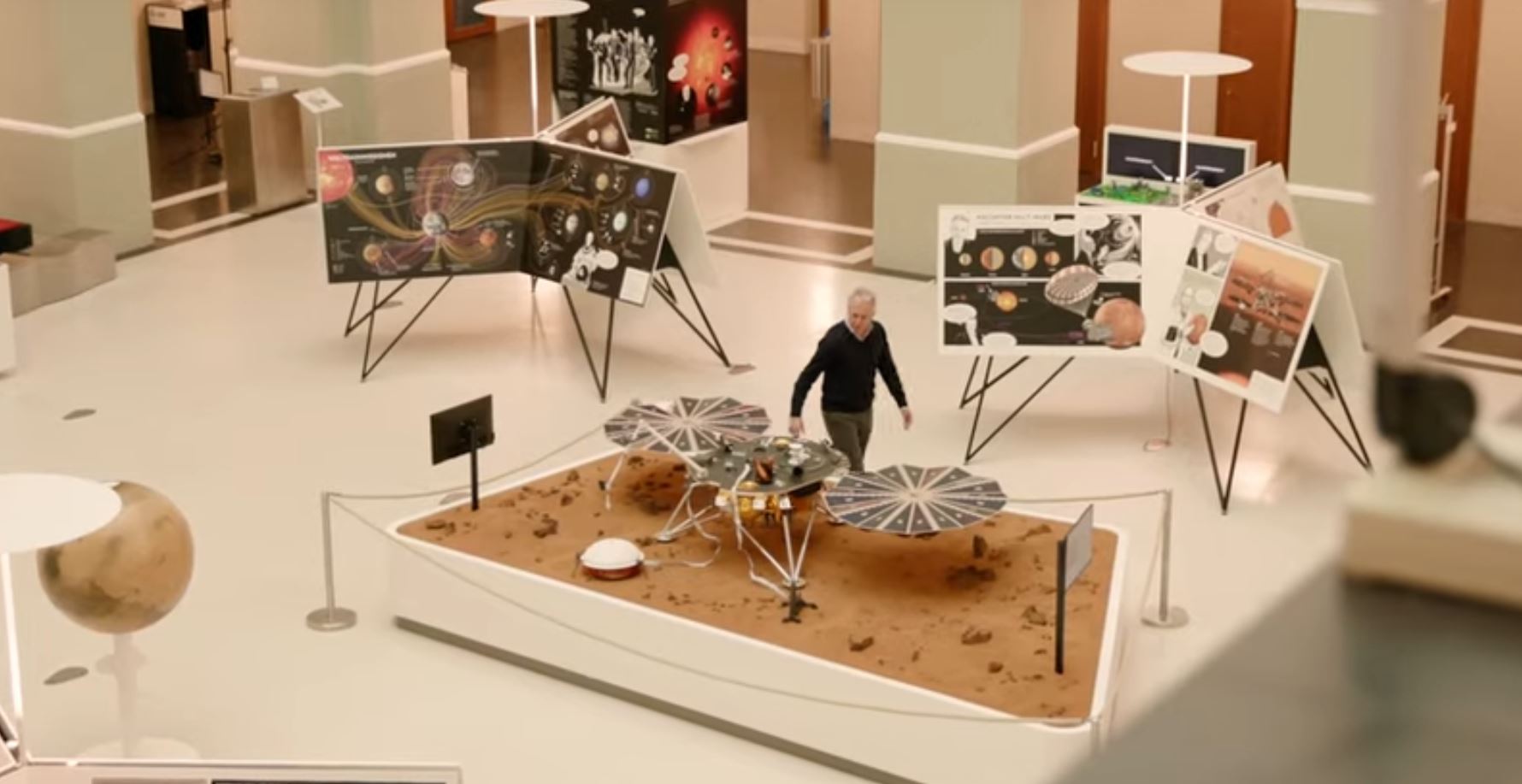
In an interview with ETH, that was published today, Domenico looks back on more than three years of work on the InSight mission.
The full interview with a short video can be found here.
2022-05-11
Largest Marsquake observed since the beginning of the NASA InSight mission
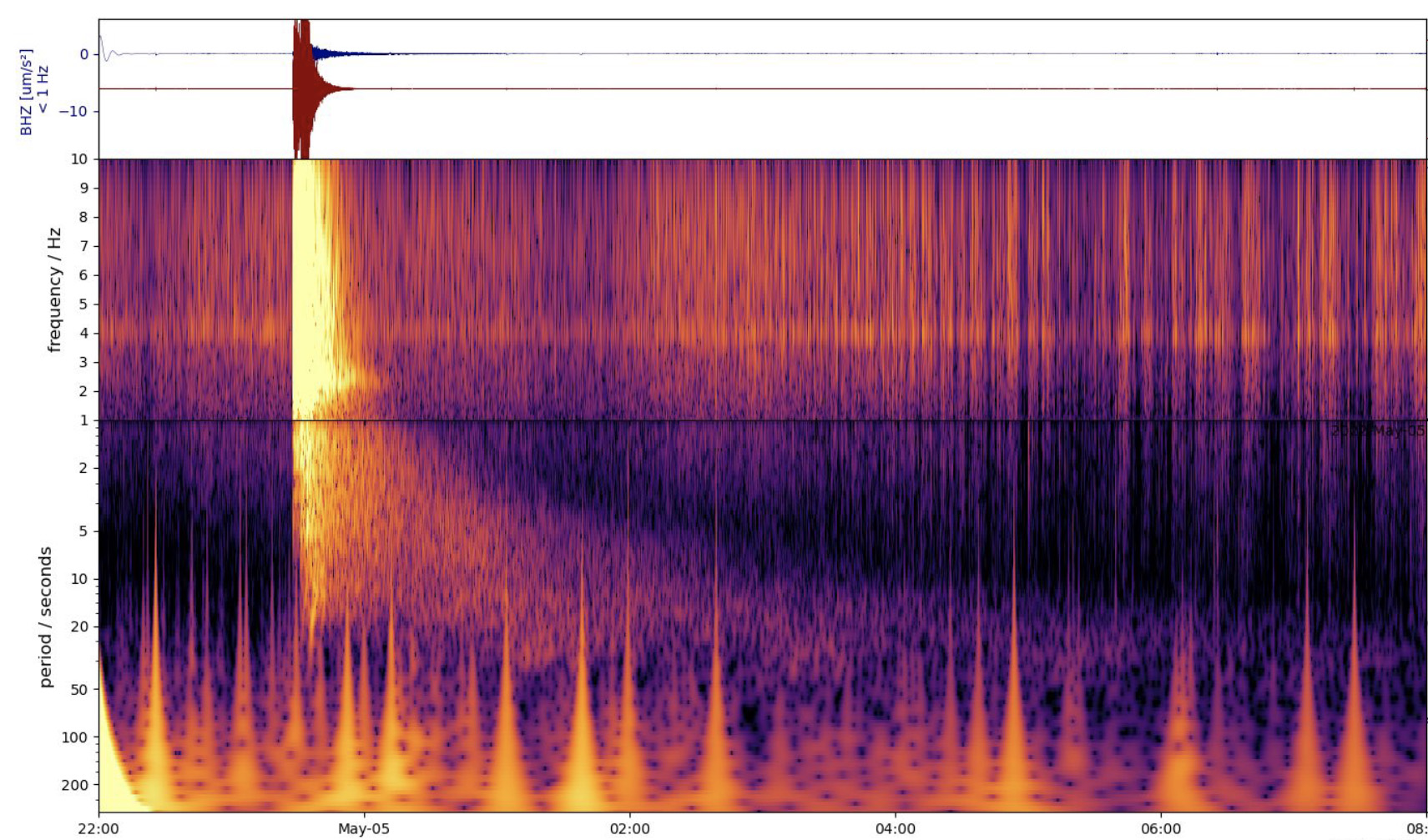
On 4 May 2022, NASA’s InSight Mars lander detected the largest quake ever observed on another planet: an estimated magnitude 5 event. The largest previously recorded quake on the red planet was a magnitude 4.2 detected on 25 August 2021.
The recent M5 event, labelled S1222a as the event occurred on the Martian day Sol 1,222 of the mission, was detected by a graduate student at ETH Zurich on duty at the time when the signals were analysed on Earth. It was not hard to spot though - the event is so large it has by far the strongest signal since the beginning of the mission, despite the event occurring in a season where almost no marsquakes are observed due to high winds disturbing the signal.
A magnitude 5 quake is a medium-size quake compared to those felt on Earth, but it’s close to the upper limit of what scientists hoped to see on Mars during InSight’s mission. The science team will need to study this new quake further before being able to provide details such as its location, the nature of its source, and what it might tell us about the interior of Mars.
Shortly after recording the event, Insight went into safe mode - where the spacecraft suspends all but the most essential functions to save energy - due on-going issues with low power associated with mounting dust on the solar panels. It is possible that S1222a is one of the very last events Insight will record. With over 1,300 events already catalogued, it is most likely Mars saved the best until last.
InSight is equipped with a highly sensitive seismometer provided by Centre National d’Études Spatiales (CNES) in France, and a digitizer provided by ETH Zurich in Switzerland. The ETH Zurich team in close collaboration with the Swiss Seismological Service also coordinates Insight’s Marsquake Service that screen the data for seismic energy, characterize marsquakes and curate the marsquake catalogue.
2022-07-04
InSight in the annual report of ETH Zurich
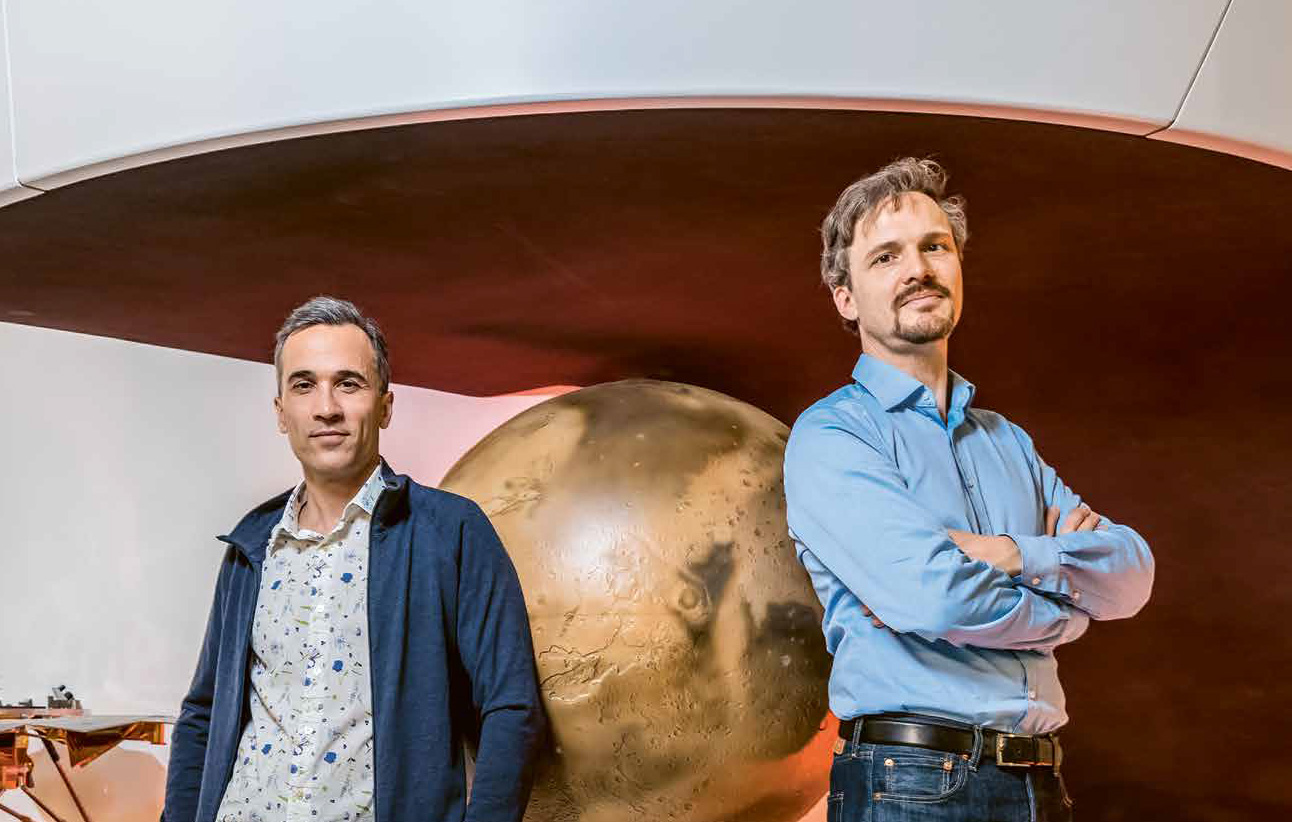
The Insight mission and its findings were acknowledged in ETH’s annual report 2021.
You can download the report here.
TV & Radio
Anche Marte ha i suoi terremoti (RSI Rete Uno, Radiogiornale 18.30, 24.2.2020)
Mars: l'EPFZ en mission (RTS Un, Le journal 19h30, 5.5.2018)
Bei der neuesten Mars-Mission "InSight" der Nasa sind auch Messgeräte der ETH Zürich dabei (SRF 1, Tagesschau Spätausgabe, 5.5.2018)
Die NASA will das Innere des Mars erforschen (SRF 1, Tagesschau Hauptausgabe, 4.5.2018)
La Svizzera partecipa a una missione internazionale su Marte (RSI LA 1, Telegiornale sera, 4.5.2018)
Forscher der NASA wollen dem Mars seine innersten Geheimnisse entlocken (SRF 1, Tagesschau 18.00, 4.5.2018)
Online
La planète Mars tremble e livre quelques secrets (tdg.ch, 25.2.2020)
InSight: Der Mars bebt häufig, aber sachte (24.2.2020)
Der Mars bebt und rumpelt (nzz.ch, 24.2.2020)
Der Pulsschlag des Roten Planeten (derbund.ch, 24.2.2020)
Der Pulsschlag des Roten Planeten (Tagesanzeiger, 24.2.2020)
3, 2, 1...liftoff! ETH Zurich is onboard NASA's InSight mission to Mars (cnnmoney.ch, 7.5.2018)
Schweizer Wissen unterstützt neue Weltraummission (cafe-europe.info, 7.5.2018)
Schweizer Fachwissen stützt neue Weltraummission (greaterzuricharea.com, 7.5.2018)
Sur Mars avec l’EPF de Zurich (laliberte.ch, 7.5.2018)
Ein Stück Zürich fliegt zum Mars (nzz.ch, 6.5.2018)
InSight into Red Planet NASA's mission to Mars launches with Swiss technology onboard (swissinfo.ch, 6.5.2018)
ETH fühlt den Puls des Mars (blick.ch, 5.5.2018)
Nasa-Raumsonde InSight Richtung Mars gestartet (20min.ch, 5.5.2018)
«InSight»-Lander zum Roten Planeten gestartet (srf.ch, 5.5.2018)
Mission «InSight» gestartet: Die Landefähre ist zum Mars aufgebrochen (nzz.ch, 5.5.2018)
Jetzt startet ETH-Sonde zum Mars (tagesanzeiger.ch, 5.5.2018)
Schweizer Computer fliegt zum Mars (toponline.ch, 4.5.2018)
Schweizer Fachwissen stützt neue Weltraummission (unternehmerzeitung.ch, 4.5.2018)
Un sismomètre de l'EPFZ va s'envoler sur Mars (lematin.ch, 4.5.2018)
Expedition ins Innere des Mars (nzz.ch, 4.5.2018)
Nasa-Marslander Insight soll am Samstag ins All starten (DerStandard.at, 2.5.2018)
Schweizer Qualität Seismograf entlockt dem Mars Geheimnisse (swissinfo.ch, 2.5.2018)
InSIGHT va ausculter Mars pour nous permettre de mieux la comprendre (letemps.ch, 1.5.2018)
Die ETH Zürich fliegt zum Mars (Der Bund, 30.4.2018)
ETH-Forscher wollen mit Nasa-Mission das Innere des Mars erkunden (blick.ch, 30.4.2018)
Europäer fotografieren den Mars (Wiener Zeitung Online, 30.4.2018)
Die ETH Zürich fliegt zum Mars (tagesanzeiger.ch, 30.4.2018)
ETH-Forscher wollen das Innere des Mars erkunden (Futurezone.ORF.at, 29.4.2018)
La mission InSight dévoile ce qui agite le sous-sol martien (Le Temps, 26.2.2020)
Unser roter Nachbar bebt und rumpelt (Neue Zürcher Zeitung, 26.2.2020)
Am Puls des Mars (Süddeutsche Zeitung, 26.2.2020)
Marte, il suolo treme come sulla Terra (Corriere della Sera, 25.2.2020)
Auf dem Mars bebt es jeden Tag (Solothurner Zeitung, 25.2.2020)
Der Pulsschlag des Roten Planeten (Berner Zeitung, Ausgabe Stadt + Region Bern, 25.2.2020)
InSight: Der Mars bebt häufig, aber sachte (Keystone SDA, Schweizerische Depeschenagentur, 24.2.2020)
Ein Stück Zürich fliegt zum Mars (Neue Zürcher Zeitung NZZ, 7.5.2018)
Hier startet die ETH-Sonde zum Mars (Basler Zeitung, 7.5.2018)
Nasa-Raumsonde InSight gestartet (20 Minuten Zürich, 5.5.2018)
Expedition ins Innere des Mars (Neue Zürcher Zeitung NZZ, 4.5.2018)
InSight, une plongée dans les mystérieux sous-sols de Mars (Le Temps, 3.5.2018)
Den Mars entzaubern (Berner Zeitung, Ausgabe Stadt + Region Bern, 1.5.2018)
ETH will das Marsinnere erkunden (Der Landbote, 30.4.2018)
Bestes Seismometer für den Mars (Tages-Anzeiger, 30.4.2018)
ETH-Forscher wollen mit Nasa-Mission das Innere des Mars erkunden (Schweizerische Depeschenagentur SDA, 29.4.2018)




